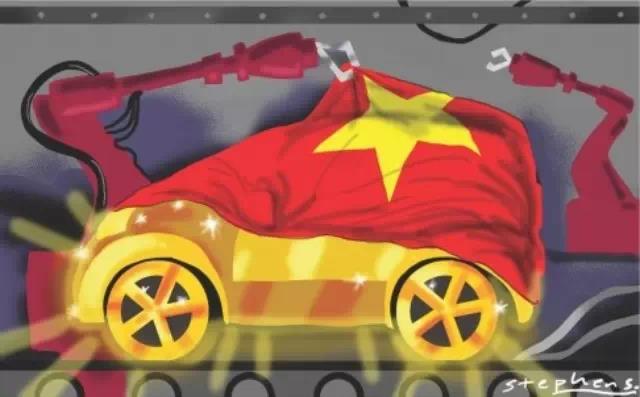
Author: Edward Tse and Bill Russo
Source: 《South China Morning Post》
Restructuring will set stage for new golden age of China’s auto industry
Edward Tse and Bill Russo say the days of rapacious growth may be over for China’s auto industry, but it will still set the pace with its sheer market size and mobile technology
After a decade of breathtaking growth, China surpassed the United States as the world’s largest automotive market in 2009. Since then, in spite of a recovery in US sales, China has widened the gap, with sales of 23.5 million vehicles compared with 17 million in the US.
However, the 7 per cent growth of last year was about half that achieved in 2013. In fact, China has witnessed single-digit growth in three of the past four years, prompting many market followers to label this the “new normal”. Some say the best times for China’s automotive industry are now in the past.
Indeed, there are many reasons to worry. In addition to the overall slowdown of China’s economy, a growing number of cities are implementing curbs on car sales, seeking to address concerns about congestion and emissions. Last month, Shenzhen joined a growing list of cities, including Beijing, Tianjin , Shanghai, Guangzhou, Hangzhou and Guiyang , in an effort to cut the growth of the car population by limiting purchases.
Meanwhile, the rising inventory of unsold vehicles has prompted the China Automobile Dealers Association to openly challenge global brand-name manufacturers, including BMW and Toyota, to increase incentives to their dealers and lower sales targets for 2015. While there is certainly cause for concern in the near term, we believe China’s auto market is moving into a new phase, one that still offers the most profitable growth opportunities in the world for both local and global carmakers. Indeed, China’s auto industry is on the cusp of major change that will fundamentally reshape things, bringing both opportunities and challenges.
The age of inefficient, asset-driven growth is over. Overall, there is a capacity bubble after some manufacturers over-estimated growth prospects.The problem is worst at the middle and lower end of the market. An already hyper-competitive environment will become more cutthroat as manufacturers try to undercut competitors’ prices to sell excess stock.
Restructuring China’s auto industry is essential to ensure its stable and healthy development. Government policies were implemented over 30 years ago to allow China to acquire the capabilities and capital from foreign sources to build up its domestic industry. While this has helped spur overall growth, it has not yielded a strong base of domestic carmakers. Consolidation and the elimination of weaker brands is inevitable.
China’s automotive industry will continue to expand, but at a more sustainable rate, with a steady stream of first-time purchasers from lower-tier cities joining the repeat buyers and those upgrading in the more established regions.
A more “binary” market will emerge, with consumers in upper-tier cities continuing to prefer global brands, while those in lower-tier cities will seek no-frills products.
However, pockets of “new wealth” will emerge in lower-tier cities, too, and these people will begin to mimic the buying patterns of more affluent customers.
This presents unique opportunities for both foreign and domestic manufacturers. For example, Ford and Great Wall anticipated the shift towards small SUVs and have been enjoying above-average growth. Likewise, European luxury carmakers, such as Audi, BMW, Mercedes-Benz and Land Rover, have seen sales rise exponentially in recent years as a result of the growth in the number of high-net-worth consumers.
In future, new segments, such as crossover and multi-purpose vehicles, may emerge but they may not be as large or as profitable as the SUV/luxury sectors. Thus, we believe a new golden age is on the horizon for China’s auto industry. China remains the largest and fastest-growing automotive market in the world. After years of advances in mobile connectivity, big data and social networks, “internet of vehicles” technology is now shaping the industry as “connected mobility” drives advances in navigation, analytics, driver safety and driver assistance.
The old automotive industry model – a way to provide mobility for middle-class consumers – no longer fits the Chinese context, creating opportunities for innovation.
A new solution to personal urban mobility is likely to emerge in China, given the scale of its urban transport challenges and increasing concerns over the environmental impact of conventional vehicles. Indeed, the traditional car-ownership model is being reshaped by urbanisation, the rising aspirations of young consumers, and the development of communications technology and “big data”.
A number of new concepts are emerging, bringing non-traditional players, many of whom are Chinese, into the ecosystem. Examples include taxi-hailing apps such as Alibaba’s Kuaidi Dache and Tencent’s Didi Dache, which each process over 5 million transactions a day.
As the leading automotive market, China is poised to revolutionise the global car industry, ushering in the next age of smart vehicles and connected mobility.
Edward Tse is founder and CEO, and Bill Russo is managing director, at Gao Feng Advisory Company, a global strategy and management consulting firm with roots in Greater China
This article appeared in the South China Morning Post print edition as New golden age

